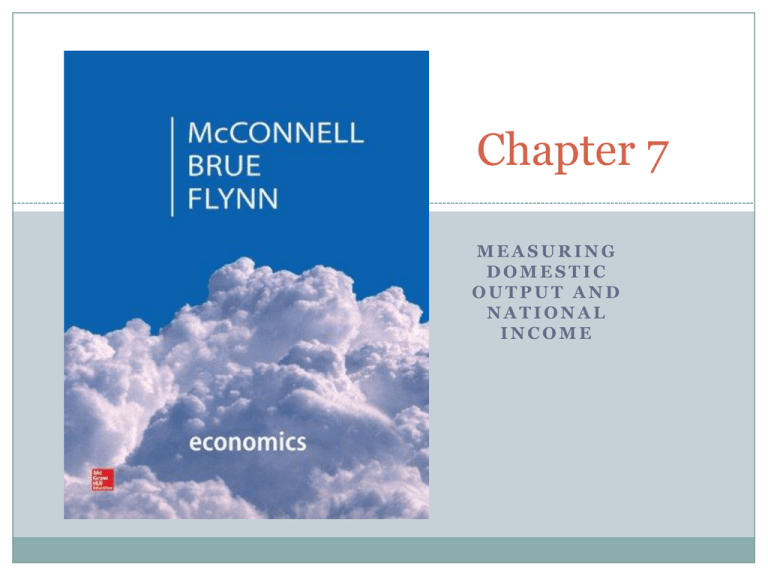
Chapter 7
MEASURING
DOMESTIC
OUTPUT AND
NATIONAL
INCOME
Taylor Economics – Chapter 7
1. Suppose the total monetary value of all final goods
and services produced in a particular country in
2008 is $500 billion and the total monetary value
of final goods and services sold is $450 billion. We
can conclude that:
a) GDP in 2008 is $450 billion.
b) NDP in 2008 is $450 billion.
c) GDP in 2008 is $500 billion.
d) inventories in 2008 fell by $50 billion.
Copyright © Houghton Mifflin Company. All rights
reserved.
Taylor Economics – Chapter 7
1. Suppose the total monetary value of all final goods
and services produced in a particular country in
2008 is $500 billion and the total monetary value
of final goods and services sold is $450 billion. We
can conclude that:
a) GDP in 2008 is $450 billion.
b) NDP in 2008 is $450 billion.
c) GDP in 2008 is $500 billion.
d) inventories in 2008 fell by $50 billion.
Copyright © Houghton Mifflin Company. All rights
reserved.
Taylor Economics – Chapter 7
2. If depreciation (consumption of fixed capital)
exceeds domestic investment, we can conclude
that:
a) nominal GDP is rising but real GDP is declining.
b) net investment is negative.
c) the economy is importing more than it exports.
d) the economy's production capacity is expanding.
Copyright © Houghton Mifflin Company. All rights
reserved.
Taylor Economics – Chapter 7
2. If depreciation (consumption of fixed capital)
exceeds domestic investment, we can conclude
that:
a) nominal GDP is rising but real GDP is declining.
b) net investment is negative.
c) the economy is importing more than it exports.
d) the economy's production capacity is expanding.
Copyright © Houghton Mifflin Company. All rights
reserved.
Taylor Economics – Chapter 7
3. Real GDP measures:
a) current output at current prices.
b) current output at base year prices.
c) base year output at current prices.
d) base year output at current exchange rates.
Copyright © Houghton Mifflin Company. All rights
reserved.
Taylor Economics – Chapter 7
3. Real GDP measures:
a) current output at current prices.
b) current output at base year prices.
c) base year output at current prices.
d) base year output at current exchange rates.
Copyright © Houghton Mifflin Company. All rights
reserved.
Taylor Economics – Chapter 7
4. Real GDP and nominal GDP differ because the
real GDP:
a) is adjusted for changes in the volume of
intermediate transactions.
b) includes the economic effects of international
trade.
c) has been adjusted for changes in the price level.
d) excludes depreciation charges.
Copyright © Houghton Mifflin Company. All rights
reserved.
Taylor Economics – Chapter 7
4. Real GDP and nominal GDP differ because the
real GDP:
a) is adjusted for changes in the volume of
intermediate transactions.
b) includes the economic effects of international
trade.
c) has been adjusted for changes in the price
level.
d) excludes depreciation charges.
Copyright © Houghton Mifflin Company. All rights
reserved.
Taylor Economics – Chapter 7
5. The GDP tends to:
a) overstate economic welfare because it does not
include certain nonmarket activities such as the
productive work of housewives.
b) understate economic welfare because it includes
expenditures undertaken to offset or correct
pollution.
c) understate economic welfare because it does not take
into account increases in leisure.
d) overstate economic welfare because it does not reflect
improvements in product quality.
Copyright © Houghton Mifflin Company. All rights
reserved.
Taylor Economics – Chapter 7
5. The GDP tends to:
a) overstate economic welfare because it does not
include certain nonmarket activities such as the
productive work of housewives.
b) understate economic welfare because it includes
expenditures undertaken to offset or correct
pollution.
c) understate economic welfare because it does
not take into account increases in leisure.
d) overstate economic welfare because it does not reflect
improvements in product quality.
Copyright © Houghton Mifflin Company. All rights
reserved.
Taylor Economics – Chapter 7
6. The monetary value of all final goods and services
produced by the United States economy during a
year is:
a. NDP
b. GDP
c. NI
d. DI
Copyright © Houghton Mifflin Company. All rights
reserved.
Taylor Economics – Chapter 7
6. The monetary value of all final goods and services
produced by the United States economy during a
year is:
a. NDP
b. GDP
c. NI
d. DI
Copyright © Houghton Mifflin Company. All rights
reserved.
Taylor Economics – Chapter 7
7. Which would be considered an investment
according to economists?
a) The purchase of newly-issued shares of stock in
Microsoft
b) The construction of a new computer chip factory
by Intel
c) The purchase of shares of stock by Fidelity, a
mutual fund company
d) The sale of government bonds by the nation's
central bank
Copyright © Houghton Mifflin Company. All rights
reserved.
Taylor Economics – Chapter 7
7. Which would be considered an investment
according to economists?
a) The purchase of newly-issued shares of stock in
Microsoft
b) The construction of a new computer chip
factory by Intel
c) The purchase of shares of stock by Fidelity, a
mutual fund company
d) The sale of government bonds by the nation's
central bank
Copyright © Houghton Mifflin Company. All rights
reserved.
Taylor Economics – Chapter 7
8. The following are national income account data
for a hypothetical economy in billions of dollars:
gross private domestic investment ($320); imports
($35); exports ($22); personal consumption
expenditures ($2,460); and, government purchases
($470). What is GDP in this economy?
a) $3,250 billion
b) $3,263 billion
c) $3,237 billion
d) $3,290 billion
Copyright © Houghton Mifflin Company. All rights
reserved.
Taylor Economics – Chapter 7
8. The following are national income account data
for a hypothetical economy in billions of dollars:
gross private domestic investment ($320); imports
($35); exports ($22); personal consumption
expenditures ($2,460); and, government purchases
($470). What is GDP in this economy?
a) $3,250 billion
b) $3,263 billion
c) $3,237 billion
d) $3,290 billion
Copyright © Houghton Mifflin Company. All rights
reserved.
Taylor Economics – Chapter 7
9. GDP in an economy is $4,600 billion. Consumer
expenditures are $3,500 billion, government
purchases are $900 billion, and gross private
domestic investment is $400 billion. Net exports
are:
a) +$400 billion
b) -$400 billion
c) +$200 billion
d) -$200 billion
Copyright © Houghton Mifflin Company. All rights
reserved.
Taylor Economics – Chapter 7
9. GDP in an economy is $4,600 billion. Consumer
expenditures are $3,500 billion, government
purchases are $900 billion, and gross private
domestic investment is $400 billion. Net exports
are:
a) +$400 billion
b) -$400 billion
c) +$200 billion
d) -$200 billion
Copyright © Houghton Mifflin Company. All rights
reserved.
Taylor Economics – Chapter 7
10. A consumer price index attempts to measure
changes in:
a) The prices of all goods and services produced by
the U.S. economy
b) The price of a select market basket of goods and
services
c) The spending patterns of all consumers in the
United States
d) The spending patterns of consumers worldwide
Copyright © Houghton Mifflin Company. All rights
reserved.
Taylor Economics – Chapter 7
10. A consumer price index attempts to measure
changes in:
a) The prices of all goods and services produced by
the U.S. economy
b) The price of a select market basket of
goods and services
c) The spending patterns of all consumers in the
United States
d) The spending patterns of consumers worldwide
Copyright © Houghton Mifflin Company. All rights
reserved.








